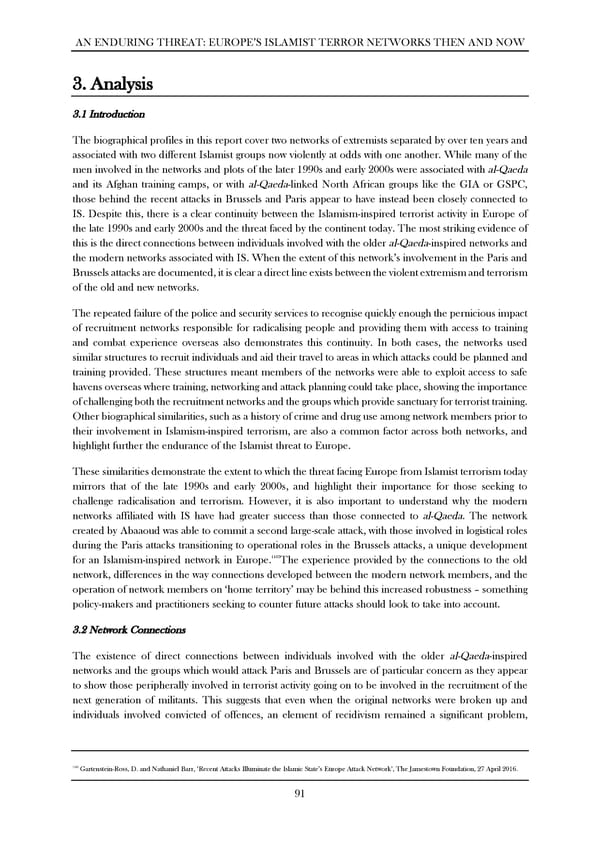AN ENDURING THREAT: EUROPE’S ISLAMIST TERROR NETWORKS THEN AND NOW 3. Analysis ! 3.1 Introduction The biographical profiles in this report cover two networks of extremists separated by over ten years and associated with two different Islamist groups now violently at odds with one another. While many of the men involved in the networks and plots of the later 1990s and early 2000s were associated with al-Qaeda and its Afghan training camps, or with al-Qaeda-linked North African groups like the GIA or GSPC, those behind the recent attacks in Brussels and Paris appear to have instead been closely connected to IS. Despite this, there is a clear continuity between the Islamism-inspired terrorist activity in Europe of the late 1990s and early 2000s and the threat faced by the continent today. The most striking evidence of this is the direct connections between individuals involved with the older al-Qaeda-inspired networks and the modern networks associated with IS. When the extent of this network’s involvement in the Paris and Brussels attacks are documented, it is clear a direct line exists between the violent extremism and terrorism of the old and new networks. The repeated failure of the police and security services to recognise quickly enough the pernicious impact of recruitment networks responsible for radicalising people and providing them with access to training and combat experience overseas also demonstrates this continuity. In both cases, the networks used similar structures to recruit individuals and aid their travel to areas in which attacks could be planned and training provided. These structures meant members of the networks were able to exploit access to safe havens overseas where training, networking and attack planning could take place, showing the importance of challenging both the recruitment networks and the groups which provide sanctuary for terrorist training. Other biographical similarities, such as a history of crime and drug use among network members prior to their involvement in Islamism-inspired terrorism, are also a common factor across both networks, and highlight further the endurance of the Islamist threat to Europe. These similarities demonstrate the extent to which the threat facing Europe from Islamist terrorism today mirrors that of the late 1990s and early 2000s, and highlight their importance for those seeking to challenge radicalisation and terrorism. However, it is also important to understand why the modern networks affiliated with IS have had greater success than those connected to al-Qaeda. The network created by Abaaoud was able to commit a second large-scale attack, with those involved in logistical roles during the Paris attacks transitioning to operational roles in the Brussels attacks, a unique development 1162 for an Islamism-inspired network in Europe. The experience provided by the connections to the old network, differences in the way connections developed between the modern network members, and the operation of network members on ‘home territory’ may be behind this increased robustness – something policy-makers and practitioners seeking to counter future attacks should look to take into account. 3.2 Network Connections The existence of direct connections between individuals involved with the older al-Qaeda-inspired networks and the groups which would attack Paris and Brussels are of particular concern as they appear to show those peripherally involved in terrorist activity going on to be involved in the recruitment of the next generation of militants. This suggests that even when the original networks were broken up and individuals involved convicted of offences, an element of recidivism remained a significant problem, ! ! 1162 Gartenstein-Ross, D. and Nathaniel Barr, ‘Recent Attacks Illuminate the Islamic State’s Europe Attack Network’, The Jamestown Foundation, 27 April 2016. ! ! 91 !
 An Enduring Threat: Europe’s Islamist Terror Networks Then and Now Page 95 Page 97
An Enduring Threat: Europe’s Islamist Terror Networks Then and Now Page 95 Page 97